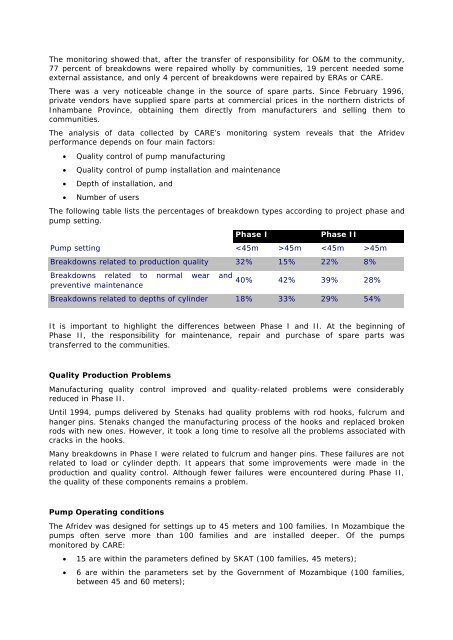Mozambique - The Water, Sanitation and Hygiene
Mozambique - The Water, Sanitation and Hygiene
Mozambique - The Water, Sanitation and Hygiene
- No tags were found...
You also want an ePaper? Increase the reach of your titles
YUMPU automatically turns print PDFs into web optimized ePapers that Google loves.
<strong>The</strong> monitoring showed that, after the transfer of responsibility for O&M to the community,77 percent of breakdowns were repaired wholly by communities, 19 percent needed someexternal assistance, <strong>and</strong> only 4 percent of breakdowns were repaired by ERAs or CARE.<strong>The</strong>re was a very noticeable change in the source of spare parts. Since February 1996,private vendors have supplied spare parts at commercial prices in the northern districts ofInhambane Province, obtaining them directly from manufacturers <strong>and</strong> selling them tocommunities.<strong>The</strong> analysis of data collected by CARE’s monitoring system reveals that the Afridevperformance depends on four main factors:• Quality control of pump manufacturing• Quality control of pump installation <strong>and</strong> maintenance• Depth of installation, <strong>and</strong>• Number of users<strong>The</strong> following table lists the percentages of breakdown types according to project phase <strong>and</strong>pump setting.Phase IPhase IIPump setting 45m 45mBreakdowns related to production quality 32% 15% 22% 8%Breakdowns related to normal wear <strong>and</strong>preventive maintenance40% 42% 39% 28%Breakdowns related to depths of cylinder 18% 33% 29% 54%It is important to highlight the differences between Phase I <strong>and</strong> II. At the beginning ofPhase II, the responsibility for maintenance, repair <strong>and</strong> purchase of spare parts wastransferred to the communities.Quality Production ProblemsManufacturing quality control improved <strong>and</strong> quality-related problems were considerablyreduced in Phase II.Until 1994, pumps delivered by Stenaks had quality problems with rod hooks, fulcrum <strong>and</strong>hanger pins. Stenaks changed the manufacturing process of the hooks <strong>and</strong> replaced brokenrods with new ones. However, it took a long time to resolve all the problems associated withcracks in the hooks.Many breakdowns in Phase I were related to fulcrum <strong>and</strong> hanger pins. <strong>The</strong>se failures are notrelated to load or cylinder depth. It appears that some improvements were made in theproduction <strong>and</strong> quality control. Although fewer failures were encountered during Phase II,the quality of these components remains a problem.Pump Operating conditions<strong>The</strong> Afridev was designed for settings up to 45 meters <strong>and</strong> 100 families. In <strong>Mozambique</strong> thepumps often serve more than 100 families <strong>and</strong> are installed deeper. Of the pumpsmonitored by CARE:• 15 are within the parameters defined by SKAT (100 families, 45 meters);• 6 are within the parameters set by the Government of <strong>Mozambique</strong> (100 families,between 45 <strong>and</strong> 60 meters);
















